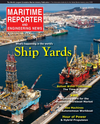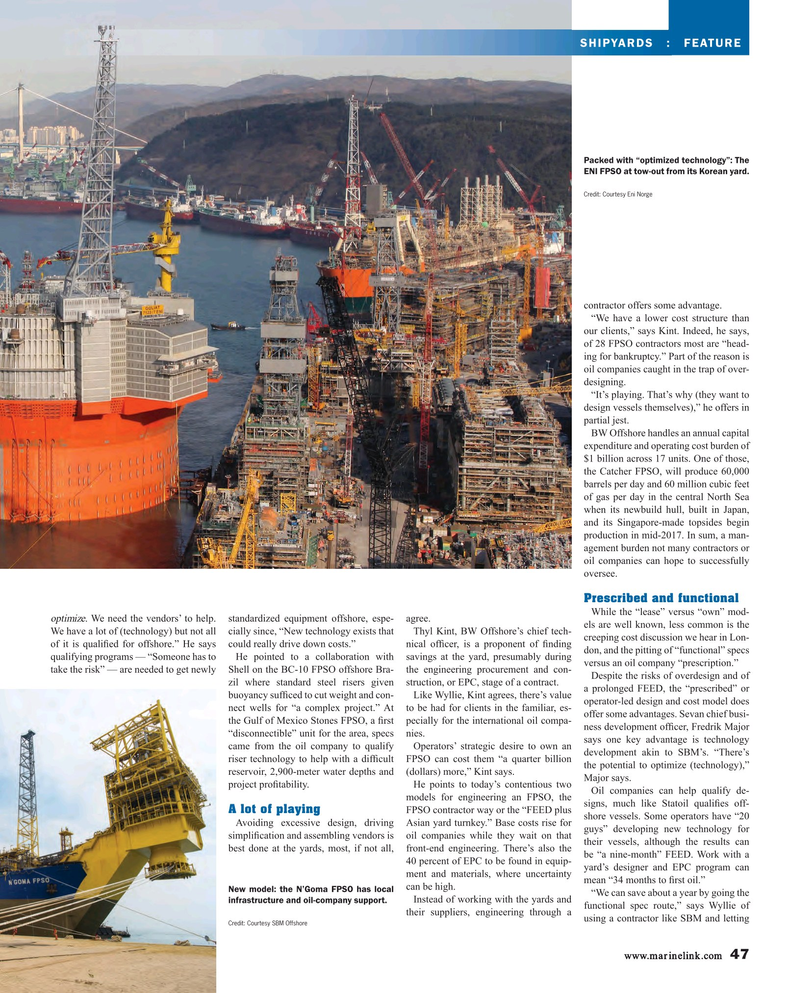
Page 47: of Maritime Reporter Magazine (August 2015)
Shipyard Edition
Read this page in Pdf, Flash or Html5 edition of August 2015 Maritime Reporter Magazine
SHIPYARDS : FEATURE
Packed with “optimized technology”: The
ENI FPSO at tow-out from its Korean yard.
Credit: Courtesy Eni Norge contractor offers some advantage. “We have a lower cost structure than our clients,” says Kint. Indeed, he says, of 28 FPSO contractors most are “head- ing for bankruptcy.” Part of the reason is oil companies caught in the trap of over- designing.
“It’s playing. That’s why (they want to design vessels themselves),” he offers in partial jest.
BW Offshore handles an annual capital expenditure and operating cost burden of $1 billion across 17 units. One of those, the Catcher FPSO, will produce 60,000 barrels per day and 60 million cubic feet of gas per day in the central North Sea when its newbuild hull, built in Japan, and its Singapore-made topsides begin production in mid-2017. In sum, a man- agement burden not many contractors or oil companies can hope to successfully oversee.
Prescribed and functional
While the “lease” versus “own” mod- optimize. We need the vendors’ to help. standardized equipment offshore, espe- agree. els are well known, less common is the
We have a lot of (technology) but not all cially since, “New technology exists that Thyl Kint, BW Offshore’s chief tech- creeping cost discussion we hear in Lon- of it is quali? ed for offshore.” He says could really drive down costs.” nical of? cer, is a proponent of ? nding don, and the pitting of “functional” specs qualifying programs — “Someone has to He pointed to a collaboration with savings at the yard, presumably during versus an oil company “prescription.” take the risk” — are needed to get newly Shell on the BC-10 FPSO offshore Bra- the engineering procurement and con-
Despite the risks of overdesign and of zil where standard steel risers given struction, or EPC, stage of a contract. a prolonged FEED, the “prescribed” or buoyancy suf? ced to cut weight and con- Like Wyllie, Kint agrees, there’s value operator-led design and cost model does nect wells for “a complex project.” At to be had for clients in the familiar, es- offer some advantages. Sevan chief busi- the Gulf of Mexico Stones FPSO, a ? rst pecially for the international oil compa- ness development of? cer, Fredrik Major “disconnectible” unit for the area, specs nies.
says one key advantage is technology came from the oil company to qualify
Operators’ strategic desire to own an development akin to SBM’s. “There’s riser technology to help with a dif? cult FPSO can cost them “a quarter billion the potential to optimize (technology),” reservoir, 2,900-meter water depths and (dollars) more,” Kint says.
Major says.
project pro? tability. He points to today’s contentious two
Oil companies can help qualify de- models for engineering an FPSO, the signs, much like Statoil quali? es off-
A lot of playing FPSO contractor way or the “FEED plus shore vessels. Some operators have “20
Avoiding excessive design, driving Asian yard turnkey.” Base costs rise for simpli? cation and assembling vendors is oil companies while they wait on that guys” developing new technology for their vessels, although the results can best done at the yards, most, if not all, front-end engineering. There’s also the be “a nine-month” FEED. Work with a 40 percent of EPC to be found in equip- ment and materials, where uncertainty yard’s designer and EPC program can mean “34 months to ? rst oil.” can be high.
New model: the N’Goma FPSO has local “We can save about a year by going the
Instead of working with the yards and infrastructure and oil-company support.
their suppliers, engineering through a functional spec route,” says Wyllie of using a contractor like SBM and letting
Credit: Courtesy SBM Offshore www.marinelink.com 47
MR #8 (42-49).indd 47 MR #8 (42-49).indd 47 7/30/2015 9:54:48 AM7/30/2015 9:54:48 AM

 46
46

 48
48
